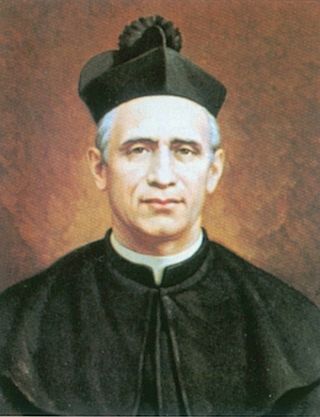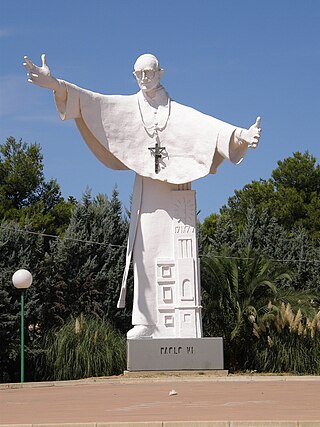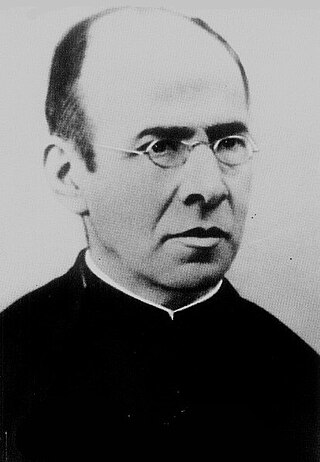
Canonization is the declaration of a deceased person as an officially recognized saint, specifically, the official act of a Christian communion declaring a person worthy of public veneration and entering their name in the canon catalogue of saints, or authorized list of that communion's recognized saints.

In the Catholic Church, the Dicastery for the Causes of Saints, previously named the Congregation for the Causes of Saints, is the dicastery of the Roman Curia that oversees the complex process that leads to the canonization of saints, passing through the steps of a declaration of "heroic virtues" and beatification. After preparing a case, including the approval of miracles, the case is presented to the pope, who decides whether or not to proceed with beatification or canonization.
Canonization of Josemaría Escrivá de Balaguer discusses John Paul II's decision to canonize Josemaría Escrivá, founder of the Prelature of the Holy Cross and Opus Dei, more commonly known as Opus Dei.

Bartholomew of Braga, born Bartolomeu Fernandes and in religious Bartolomeu dos Mártires, was a Portuguese Catholic and a professed member from the Order of Preachers as well as the Archbishop Emeritus of Braga. Fernandes participated in the Council of Trent and also collaborated with Charles Borromeo at the council while also establishing a series of hospitals and hospices in Braga while publishing a range of works from catechism to other topics.

Ciriaco María Sancha y Hervás was a Spanish cardinal of the Roman Catholic Church who served as the Archbishop of Toledo in addition to being the Primate of Spain and the Patriarch of the West Indies. He established the Sisters of Charity in 1869.

Maria Luise Merkert was a German Roman Catholic professed religious and the co-foundress of the Sisters of Saint Elizabeth. Merkert worked to help those in need including the poor and ill and tended to them with her older sister until her sudden death and the death of her other companions - this left Merkert alone to found and maintain her order as its first Superior General from 1859 until her death.

Luigi Guanella was an Italian Roman Catholic priest. He was ordained a priest on May 26, 1866 in Como, and was assigned to a small parish in Savogno. Luigi is the founder of several religious institutes: the Daughters of Saint Mary of Providence (1890) and the Servants of Charity alongside his friends David Albertario and Giuseppe Toniolo. Guanella also founded the Pious Union of Saint Joseph (1914) with his supporter and first member Pope Pius X. These religious communities focused on the relief of the poor throughout the world. The Servants of Charity motto reads "In Omnibus Charitas", which became the cornerstone for Guanella's own life.

Stanislaus Papczyński, born Jan Papczyński, was a Polish Catholic priest who founded the Marians of the Immaculate Conception, the first Polish religious order for men. Prior to starting his own order, he had been a member of the Piarist Order. He took the name of "Stanislaus of Jesus and Mary". Papczyński is widely remembered as a prolific religious writer; his writings include works such as The Mystical Temple of God.

Stanisław Kazimierczyk was a Polish Catholic priest and a professed member of the Canons Regular of the Lateran. He became noted for his ardent devotions to both the Eucharist and to his personal patron saint, Stanislaus of Szczepanów, as well as for his charitable dedication to the ill and poor of Kraków.

Giulia Salzano was an Italian Roman Catholic professed religious and the founder of the Catechetical Sisters of the Sacred Heart of Jesus (1905). Salzano served as a teacher prior to becoming a religious and since 1865 worked in Casoria as a teacher for children where she demonstrated herself as an apt catechist and instructor.
In the Catholic Church, a positio is a document or collection of documents used in the process by which a person is declared Venerable, the second of the four steps on the path to canonization as a saint.

Cecilia Eusepi was an Italian Roman Catholic and a professed member from the Secular Servites. Eusepi died of tuberculosis at 18 years of age, but only after her confessor advised her to keep a journal of her own life, which she titled Storia di un Pagliaccio, for she considered herself to be a "little clown" and "a half-stupid clown good for nothing"; she wrote that it must be her extreme weakness that appealed to God.

Maria Domenica Mantovani was an Italian Roman Catholic professed religious, and the co-founder of the Little Sisters of the Holy Family; she established them alongside Giuseppe Nascimbeni. As a nun she received the religious name of Maria of the Immaculate.

Giovanni Battista Piamarta was an Italian Roman Catholic priest and educator. Piamarta was also the founder of the Congregation of the Holy Family of Nazareth. Piamarta established his congregation in 1900 in order to promote Christian education across the Italian peninsula. Piamarta also founded the Humble Servants of the Lord.

The cause for the canonization of Pope Paul VI, who died in 1978, commenced in 1993 and he was canonized on 14 October 2018. After having been proclaimed a Servant of God and declared Venerable, he was beatified on 19 October 2014, after the recognition of a miracle had been attributed to his intercession, and declared a saint by Pope Francis on 14 October 2018.

Manuel Míguez González – in religious Faustino of the Incarnation – was a Spanish priest and a professed member from the Piarists as well as the founder of the Daughters of the Divine Shepherdess – better known as the Calasanzian Institute. He gained a rather strong reputation for being a formidable pastor and a man dedicated to both education and science while using his scientific knowledge to concoct natural medicines to aid the ill who came to him for his help. But his religious activism augmented when he saw illiterate women and those who were marginalized and so decided to establish a religious congregation to educate women.

Maria Llorença Requenses Llong was a Spanish Roman Catholic professed religious and the founder of the Capuchin Poor Clares. Llong founded the hospital of "Santa Maria del Popolo" in Naples where she relocated to and which received numerous papal privileges from Pope Leo X and Pope Adrian VI.

Gertrude Prosperi was an Italian Benedictine. Prosperi assumed the religious name Maria Luisa Angelica and finally served as the abbess of her convent for an extended period of time until her death.
Francesco Spinelli was an Italian Roman Catholic priest and the founder of the Sisters Adorers of the Blessed Sacrament. Spinelli became close contemporaries of Geltrude Comensoli and Luigi Maria Palazzolo and had a previous collaboration with Comensoli in which the two established a religious institute in Bergamo before a rift between members caused Spinelli to distance himself from its work and leave.
Maiorem hac dilectionem is an apostolic letter issued in the form of a motu proprio of Pope Francis, dated 11 July 2017. The document creates a new path towards sainthood under the canonization procedures of the Roman Catholic Church, through the path of oblatio vitae. This means the offering of one's life and premature death for another individual; it is to give one's life as a sacrifice for another.
















